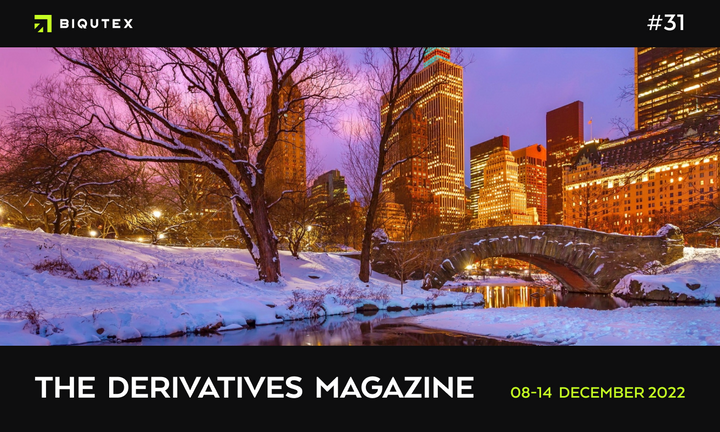The Derivatives Magazine #21

The period of low volatility in the crypto market is now in its third week. After Ether's transition to the new consensus algorithm in mid-September, the crypto market corrected slightly, but was generally within a rather narrow total capitalization of $870-950 billion. At the beginning of the week, the total capitalization index amounted to $892 billion USD, reflecting the overall slowdown within the local market.
The level of liquidations also remains neutral and is within the standard values for the low-liquid market. Despite the fact that the liquidations of long positions were one and a half times more than short positions, the market is still in the stage of consolidation, and without a noticeable directional movement the liquidations are at historical lows.
The funding rate for futures contracts with an execution date at the end of December is near zero levels for both ETH and BTC, thus reflecting the market's lack of interest in increasing the amount of risk with futures trades. The slightly negative rate for ETH reflects the retention of some hedge positions opened in August and mid-September, when a swap trade between the spot position and the September/December futures could generate a yield of 15% p.a.
The perpetual swaps market has higher activity and is characterized by a higher funding rate for margin positions than for term futures. For bitcoin, the rate lies in a wide range from -3.5% (FTX exchange), to 10% (ByBIT exchange) and indicates a lack of consolidation in traders' expectations.
For Ether, fluctuations in the funding rate also indicate a possible halt in the decline. Instead of extreme or average-weighted negative rates on the major exchanges (last week and the week before, for example), we can note at the moment that only Derebit and FTX (where rates are -20% and -11% respectively) remain dominated by short positions and open-ended futures are often used in combination with options or spot trades. At the same time, on the other major exchanges, the funding rate has entered positive territory, reflecting an increase in the volume of long positions.

The perpetual swaps market has higher activity and is characterized by a higher funding rate for margin positions than for term futures. For bitcoin, the rate lies in a wide range from -3.5% (FTX exchange), to 10% (ByBIT exchange) and indicates a lack of consolidation in traders' expectations.
For Ether, fluctuations in the funding rate also indicate a possible halt in the decline. Instead of extreme or average-weighted negative rates on the major exchanges (last week and the week before, for example), we can note at the moment that only Derebit and FTX (where rates are -20% and -11% respectively) remain dominated by short positions and open-ended futures are often used in combination with options or spot trades. At the same time, on the other major exchanges, the funding rate has entered positive territory, reflecting an increase in the volume of long positions.
Before the weekend on Friday, a total of 37k BTC and 81k ETH were withdrawn from exchanges, which may indirectly support prices this week, reducing the total amount available for sale. Perhaps, the period of low prices is used by some traders to increase the size of positions in the cryptocurrency while the environment is favorable.
After a large amount of USDT stablecoin was withdrawn from exchanges' balance sheets two weeks ago, there was no significant movement of funds. Together with the funds flow in BTC and ETH we can state another period of liquidity reduction in the market - more than 500 million USD were withdrawn from the public addresses of cryptocurrency exchanges in total.
The volume of open interest in futures contracts stabilized at $6.5 billion for ETH, and $11 billion for BTC. The market's presence in the consolidation zone coincides with stagnation in derivatives trading, confirming the thesis of a low-liquid market and a possible surge of volatility in the future.
Futures trading volume has a distinctive five-day pattern, indicating that the market is dominated by institutional participants (adhering to a strict schedule) and the level of participation by retail investors is still low. It should also be noted that BTC is again trading much more actively than ETH, in contrast to the situation of the last two months.
Last few trading sessions BTC, as the leader of the crypto segment, looked stronger than stock indices from traditional markets and the nearest competitor ETH. The end of the U.S. fiscal year, a decline in the dollar index from local highs, and oversold market conditions may encourage investors and traders to take advantage of conditions to enter the market or increase coverage on already opened positions. The process of rate hikes and balance sheet cuts by central banks could be revised downward, as recent events involving the Bank of England have shown. In case the actions of the financial authorities lead to panic in the markets and a sharp increase in volatility, the previously announced decisions are subject to prompt revision (the Bank of England rolled back the quantitative tightening program two weeks after the start as a result of the falling pound and the sell-off in the government bond market). Such situational optimism may provide short-term support to prices within the weekly cycle, but more significant macroeconomic changes are needed for the market to reverse.
This overview was prepared by the analytics department of the Biqutex crypto derivatives exchange



